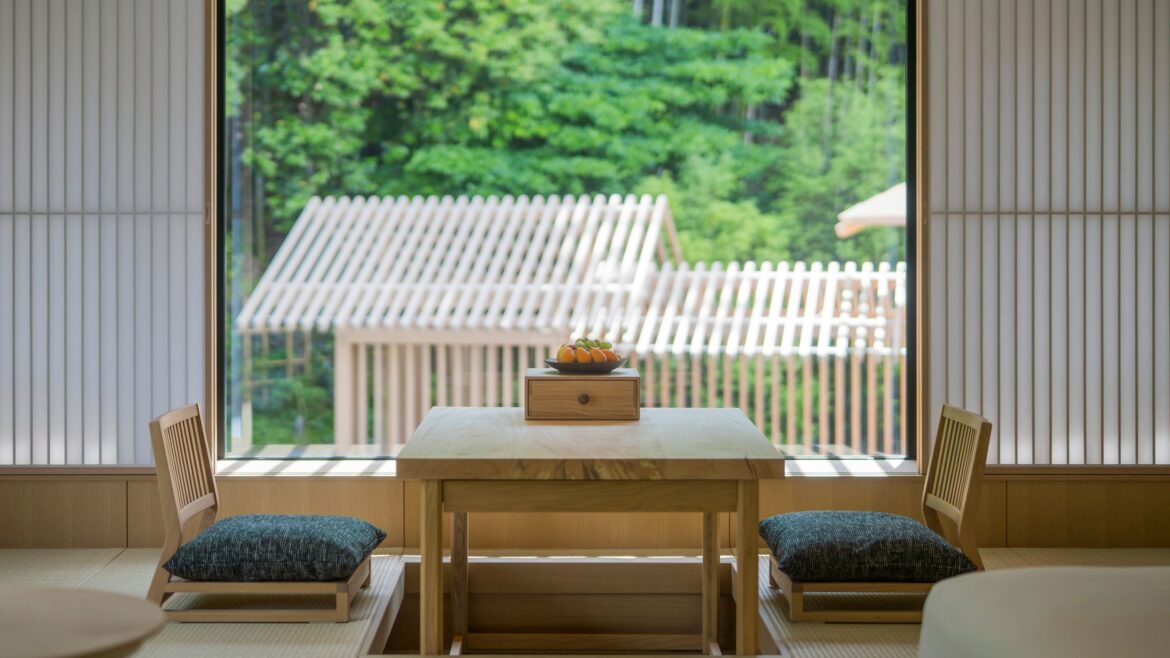Why book?
For an escapist taste of modern Kyoto serenity—thanks to its quiet hillside setting, Kengo Kuma-designed clean-lined wooden architecture, hot spring onsen bathing and peaceful rooms with sweeping city views.
Set the scene
A measured balance between accessible and peaceful—the hotel sits on the calm forested slopes of the Higashiyama Mountains on the eastern edge of the city. Wrapped in nature, it is nonetheless within short walking distance to a raft of landmark sites and neighborhoods in Kyoto—including the iconic tiered form of Yasaka Pagoda, Kiyomizu-dera Temple and the Gion district (making the hotel the perfect base for early morning crowd-dodging visits). Guests arrive by crossing a shrine-like wooden threshold—before approaching the angular geometry of Kuma’s contemporary façade of interlocked latticed wood above walls of organic stones. Inside the triple-height reception, walls of glass frame rock gardens and forests, beneath a ceiling swathed in an abstract sea of bamboo. A network of intimate spaces span the adjacent lobby lounge, where the transition from outside world to inner sanctum is completed with a whisked green taste of matcha served to welcome guests.
The backstory
It’s telling that Banyan Tree chose Kyoto as the setting for their first hotel in Japan—clearly keen to tap into the ancient city’s rich heritage of crafts, culture and wellness (as well as the famously booming tourist crowds). Inside the 52-room hotel, interiors are modern and crafted with luxury touches, complete with a Japanese restaurant, a peaceful spa, hot spring onsen baths and, at the forest-fringed rear of the property—a unique highlight—the meticulous craftsmanship of a modern Kuma-designed noh theatre.
The rooms
A modern reimagining of Japanese beauty, the rooms—designed by late Japanese designer Yukio Hashimoto—smoothly balance past and present. Picture peaceful light tones, sliding screens and expanses of aromatic tatami plus low-level platforms by the windows with sunken seating. A gentle scattering of curated Japanese artworks include the minimalist black and white ceramics creations by Eiichi Shibuya, while delicate gold leaf spans the chiselled curves of the naguri woodwork above the beds. A highlight are the centre stage bathtubs—deep Japanese-style creations, crafted from aromatic hiba wood, with a trio of small textile bags (containing green tea, roasted tea and sake lees) to aromatically infuse the water. Perhaps most remarkable for a hotel in famously low-rise Kyoto are the epic vistas, courtesy of its hillside setting: request a city-facing room for a panorama view of the city’s tiled rooftops, temple pagodas and distant mountains. Hot spring lovers should book for one of the eight special Onsen Retreat rooms—complete with their own supply of hot spring water.
Food and drink
The culinary heartbeat of the hotel is Ryozen, a signature Japanese restaurant, rooted in seasonal local cuisine with a contemporary edge, currently open only for breakfast and dinner. Here, in a serene restaurant space overlooking the noh theatre and bamboo forests, guests can enjoy poetry-on-a-plate—aka Japan’s traditional kaiseki banquet-style cuisine. Recent highlights include steamed Spanish mackerel with yuba (layered soy milk skin) and sea urchin; deep-fried taro, sliced turnip and salmon roe sushi; and grilled Yonezawa beef ichibo (premium wagyu) with vegetables and Kyoto salt. And threading it all together? The umami of a signature dashi broth created by chefs using a five-year-old aged Rishiri kelp seaweed from Hokkaido in northernmost Japan. Guests can also choose from à la carte treats ranging from grilled Tamba chicken with teriyaki sauce, soba and udon to o nigiri rice balls. Breakfast is another Japanese food journey: wooden boxes contain countless small dishes (dried baby sardine with sansho pepper, simmered eggplant with ginger, Japanese rolled omelette, grilled salmon pickled in miso, among many other treats) plus rice, miso soup and fruits in jelly. Bar Ryozen is similarly rooted in its location, specializing in sake in particular: the intimate space has an expansive menu of local Kyoto-made sake types plus regional specialities; while teas and locally crafted sweets are served during the day.
The spa
As a longtime pioneer of spa hospitality in Thailand, it’s perhaps little surprise that wellness is a key ingredient at this Banyan Tree hotel—albeit with a Japanese twist. Center stage are the Japanese-style onsen baths (gender segregated, with indoor and outdoor bathing spaces). Visitors can also relax and unwind at Banyan Tree Spa. Intimate and serene, with forest views, the spa not only offers a number of Asian-style massages (from Thai to Balinese), it’s also home to a special onsen suite, complete with private onsen bathing in a hinoki cypress wood bathtub and steam sauna. The signature Onsen Indulgence, which includes a one-hour onsen bathing experience, followed by a one-hour massage, is a standout treatment.
The neighborhood/area
Quiet but well-connected, it feels removed from the tourist crowds—yet it’s within easy reach of countless destinations, from local temples to museums (plus Kyoto station is around 10 minutes away by taxi).
The service
Warm and attentive, the staff are openly friendly and keen to help out.
For families
Kids and multi-generational family groups are warmly welcomed. There is a special menu (again with a Japanese cuisine focus) plus special amenities, including kid-sized slippers.
Eco effort
The hotel has a policy of minimal disposable amenities plus is involved in a number of initiatives (one vaccine is donated via UNICEF for every four pounds of plastic bottle caps collected).
Accessibility
There are two wheelchair-accessible rooms.


AloJapan.com